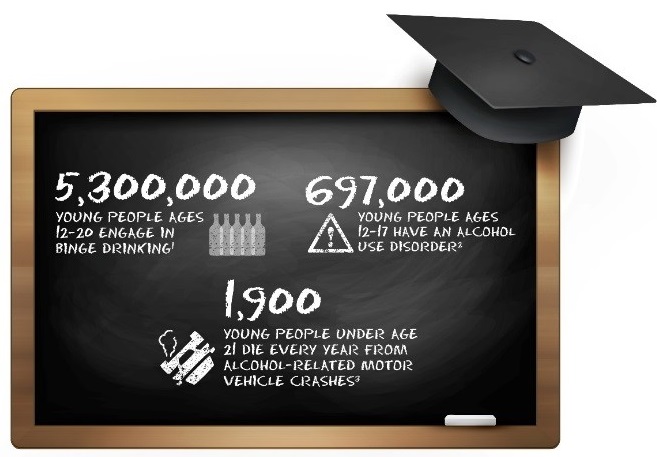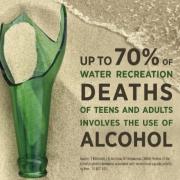NIAAA Director's Report on Institute Activities to the 143rd Meeting of the National Advisory Council on Alcohol Abuse and Alcoholism
Table of Contents
- NIAAA BUDGET
- LEGISLATIVE NEWS
- COLLABORATIVE RESEARCH ON ADDICTION AT NIH UPDATE
- DIRECTOR'S ACTIVITIES
- STAFF TRANSITIONS
- STAFF APPOINTMENTS
- HONORS & AWARDS
- NEW REQUESTS FOR APPLICATIONS AND PROGRAM ANNOUNCEMENTS
- NOTABLE NIAAA STAFF ACTIVITIES
- WHAT'S AHEAD
- NIH RESEARCH HIGHLIGHTS
- NIAAA COMMUNICATIONS ACTIVITIES
- NIAAA WELCOMES NEW COUNCIL MEMBERS
Fiscal Year (FY) 2016
The NIAAA is currently closing out fiscal year (FY) 2016 to coincide with the end of the federal FY calendar which ends September 30, 2016. In FY 2016, the National Institutes of Health (NIH) received a total of $32.3 billion, $2 billion above the FY 2015 enacted level. This funding provided support for the Precision Medicine Initiative and included specific increases for Alzheimer’s disease research, the Brain Research through Advancing Innovative Neurotechnologies (BRAIN) Initiative, antibiotic resistance research, and the Institutional Development Award program. It also provided a general increase to all NIH Institutes and Centers, and it continued support for the Gabriella Miller Kids First Pediatric Research program (Kids First).
The FY 2016 appropriation for NIAAA provided $467.7 million. This represented a $20.5 million or 4.9% increase over the FY 2015 budget level. The NIAAA appropriation included $2.7 million set aside for the BRAIN Initiative. NIAAA estimates it will support a total of 684 Research Project Grants (RPGs) in FY 2016.
FY 2017
On February 9, 2016, President Obama submitted to Congress the FY 2017 President’s Budget request for all federal agencies. Included in this request is a proposed NIH budget of $33.136 billion ($825 million more than the FY 2016 enacted NIH level), with $467.5 million proposed for NIAAA (flat compared to the FY 2016 enacted NIAAA budget). The FY 2017 appropriations bill for the NIH is still pending in Congress.
| Mechanism | FY 2016* Enacted |
FY 2017 President's Budget |
||
|---|---|---|---|---|
| Number | Amount | Number | Amount | |
| Research Projects | ||||
| Noncompeting | 479 | $187,985 | 451 | $182,100 |
| Administrative Supplements | (13) | 2,600 | (32) | 2,600 |
| Competing | 173 | 58,350 | 182 | 61,494 |
| Subtotal, RPGs | 652 | 248,935 | 633 | 246,194 |
| SBIR/STTR | 32 | 11,279 | 32 | 11,960 |
| Research Project Grants | 684 | 260,214 | 665 | 258,154 |
| Research Centers | ||||
| Specialized/Comprehensive | 20 | 30,264 | 20 | 30,021 |
| Clinical Research | - | - | - | - |
| Biotechnology | - | - | - | - |
| Comparative Medicine | - | - | - | - |
| Res. Centers in Minority Instit. | - | - | - | - |
| Subtotal, Centers | 20 | 30,264 | 20 | 30,021 |
| Other Research | ||||
| Research Careers | 92 | 14,445 | 92 | 14,500 |
| Cancer Education | - | - | - | - |
| Cooperative Clinical Research | 2 | 9,466 | 2 | 9,466 |
| Biomedical Research Support | - | - | - | - |
| Minority Biomed. Research Support | - | 340 | - | 340 |
| Other | 48 | 16,097 | 48 | 16,097 |
| Subtotal, Other Research | 142 | 40,348 | 142 | 40,403 |
| Total Research Grants | 846 | 330,826 | 827 | 328,578 |
| Training | ||||
| Individual | 111 | 4,580 | 111 | 4,656 |
| Institutional | 173 | 8,609 | 173 | 8,751 |
| Total, Training | 284 | 13,189 | 284 | 13,407 |
| Research & Develop. Contracts | 69 | 40,283 | 69 | 40,650 |
| (SBIR/STTR) | (4) | (1,916) | (4) | - |
| Intramural Research | 99 | $49,644 | 99 | $50,637 |
| Res. Management & Support | 138 |
$33,503 (10) |
140 |
$34,173 |
| Total, NIAAA Budget Authority | $467,445 | $467,445 | ||
*FY 2016 budget excludes the $255K AIDS transfer
In 2015, the House Energy and Commerce Committee passed the 21st Century Cures Act to enhance and accelerate the discovery, development, and delivery of new treatments and cures. The bill designated $8.75 billion for the NIH and $550 million for the Food and Drug Administration (FDA) over a five-year period. The Senate Health, Education, Labor and Pensions Committee is developing a Senate companion to the bill for consideration this fall. If passed, differences between the two bills will have to be negotiated to create one unified bill for both chambers of Congress to approve.
COLLABORATIVE RESEARCH ON ADDICTION AT NIH UPDATE
Adolescent Brain and Cognitive Development (ABCD) Study - The ABCD study continues to move forward. Centralized IRB approval has been obtained and the few sites relying on local IRB’s have also received approval. Three-day train-the-trainer meetings were held in San Diego, California, in April and July. Almost all sites are cleared to begin recruiting subjects in September, with the remaining sites to follow in October. Consortium-wide policies in bioethics, and publication and ancillary studies have been developed, as well as an informatics system for data capture and transfer. The protocol has been pilot-tested, refined based on pilot-testing feedback, and will be finalized before recruitment begins.
ABCD has also had success in developing partnerships with key organizations to aid in recruitment efforts including the School Superintendents Association, the American Academy of Pediatrics, the American Academy of Child and Adolescent Psychiatry, the American School Health Association, the Learning First Alliance, and the American Psychological Association. Federal partners outside of NIH who are interested in supporting the core and ancillary studies include the Centers for Disease Control and Prevention (CDC) and the National Institute of Justice.
Additional information on all CRAN activities and studies can be found at http://addictionresearch.nih.gov
NIAAA’s Director, Dr. George F. Koob, made a number of important presentations during June through September 2016.
- He was a keynote speaker at the American Society of Clinical Psychopharmacology in Scottsdale, Arizona, on June 2, 2016. His presentation was entitled “What Science Can Tell us about the Diagnosis, Prevention, and Treatment of Alcoholism.”
- He was a plenary speaker at the College on Problems of Drug Dependence (CPDD) meeting in Palm Springs, California, on June 12, 2016. The title of this presentation was “The Role of Stress in Addiction: an NIAAA Perspective.”
- He was a plenary speaker at the Research Society for Alcoholism in New Orleans, Louisiana, on June 26, 2016. His presentation was titled, “Report from the National Institute on Alcohol Abuse and Alcoholism (NIAAA) Current and Future Priorities.”
- He spoke at the Mini Symposium on Opioid Research in Bethesda, Maryland, on July 27, 2016. The title of his talk was “The Neurobiological Basis for the Dark Side of Opioid Dependence.”
- He spoke at Cold Spring Harbor in Cambridge, United Kingdom, on August 3, 2016. The subject of his talk was “Hedonic Allostasis/Stress.”
- He spoke at the California Society of Addiction Medicine in Anaheim, California, on August 25, 2016. The subject of his presentation was “Alcohol.”
- He spoke at the California Society of Addiction Medicine in Anaheim, California, on August 26, 2016. The title of talk was “The Neurobiology of Addiction.”
- He gave the opening plenary lecture at the International Society for Biomedical Research on Alcoholism and the European Society for Biomedical Research on Alcoholism (ISBRA/ESBRA) 11th International Symposium on ALPD and Cirrhosis in Berlin, Germany, on September 2, 2016. The title of the lecture was “Historical Aspects and Research Highlights of the last 50 Years of Alcohol Research.
New Staff

Anna Ghambaryan, M.D., Ph.D., joined NIAAA as a Scientific Review Officer in July 2016. Before coming to NIAAA, she was a Health Scientist/Epidemiologist at the Food and Drug Administration (FDA). Prior to joining FDA, Dr. Ghambaryan was a junior service fellow at the Agency for Healthcare Research and Quality (AHRQ). She earned her M.D. degree in general practice from Yerevan State Medical University, Armenia, an M.S. in Psychology from Brigham Young University and a Ph.D. in Medical Psychology from the Uniformed Services University of the Health Sciences.

Yvonne Horneffer, M.S.N., C.R.N.P., has joined NIAAA’s intramural clinical program. She is a board certified Adult Nurse Practitioner. She earned her Master of Science in Nursing in 2001 from George Mason University in collaboration with the George Washington University School of Medicine. Prior to joining NIAAA, Yvonne was an Associate Investigator at the National Cancer Institute’s early drug development program from 2006 to 2016 conducting Phase 0 and Phase 1 clinical trials. Yvonne is also a Certified Nephrology Nurse who served as an Associate Investigator at NIDDK’s kidney and pancreas transplant program from 2004 to early 2006.

Timothy Karacki joined the Financial Management Branch (FMB) in July 2016. Previously, he worked as a Financial Analyst in the Contract Finance Department of Lockheed Martin. Timothy earned his bachelor’s degree in Mathematics and Economics from Dickinson College and his master’s degree in Business Administration from the University of Maryland

Jennifer Leese has joined OD/ORM at NIAAA. Previously she was an Administrative Technician in the Department of Management Services at the National Institute of Nursing Research where she served as an Administrative Technician for both intramural and extramural areas.

Donna Stringfield joined NIAAA in June 2016 as an Extramural Support Assistant in the Office of the Director/Office of Extramural Activities (OD/OEA). Before joining NIAAA, she was an Administrative Assistant at Chamberlin Edmonds Hospital, a Fiscal Support Technician at Cape Fear Public Utility Authority both in Wilmington, North Carolina, and a Program Support Assistant at NIH’s Center for Scientific Review.
Tonette Vinson, C.R.N.P., O.C.N., has joined NIAAA’s intramural clinical program as an Adult Nurse Practitioner. She earned her Masters of Science in nursing from The University of Pennsylvania in 2003. Prior to joining NIAAA Tonette was a Nurse Practitioner at the National Cancer Institute and responsible for managing lymphoma, hairy cell leukemia, HIV, HTLV-1 associated ATL, and multiple myeloma patient needs in the inpatient and outpatient setting. She is also an Oncology Certified Nurse.

Vicki Buckley has been appointed to the Senior Executive Service in the position of Associate Director for Administration (Executive Officer) for NIAAA. Vicki joined NIAAA in May 2015 as Deputy Executive Officer and became the Acting Executive Officer in August 2015. Prior to joining NIAAA, Vicki served as the Deputy Executive Officer/Acting Executive Officer for the National Eye Institute (NEI) since January 2013. Prior to NEI, she worked at the National Institute on Mental Health (NIMH) from 1999 to 2013, serving in numerous administrative roles including over three years as the Chief Administrative Officer for the NIMH Intramural Research Program. Vicki earned a B.S. in Health Care Management from Southern Illinois University, and a Master’s in Business Administration from Mt. Saint Mary’s University. In her role at NIAAAA, Vicki oversees all of the administrative functions of the Institute and facilitates the smooth operation of the Institute.

M. Katherine Jung, Ph.D., has been selected as Director of the Division of Metabolism and Health Effects (DMHE). Dr. Jung led the NIAAA Biosensor Challenge, serves as NIAAA’s SBIR/STTR coordinator and has been a program officer in DMHE for many years. Dr. Jung earned her Ph.D. in biochemistry from Ohio State University. She has worked and published in the areas of cell biology, alcohol induced organ damage, cancer biology, and drug discovery. Dr. Jung has an enduring interest in the effect of alcohol consumption on the propensity to organ damage and on impairment of host defense. In her new role, she will lead DMHE in promoting the highest quality research that seeks to understand the mechanisms of alcohol’s pathological effects on organ function, with the goal of improving patient care
Dr. George Koob received the insignia of Chevalier de la Légion d’honneur (Knight of the Legion of Honor) from the government of France in recognition of his contribution to the development of scientific collaborations between France and the United States. The award ceremony took place on Thursday, June 30, 2016, at the Washington, D.C., residence of French Ambassador Gerard Araud, who presented the award to Dr. Koob on behalf of French President Francois Hollande.
Several NIAAA Staff received 2016 NIH Director’s Awards:
- Dr. Bridget Williams-Simmons, Dr. Jennifer Hobin and Dr. Patricia Powell, “for significant contributions toward developing an NIH-wide Strategic Plan.”
- Dr. Vivian Faden, Mr. Fred Donodeo and Ms. Maureen Gardner “for sustained and extraordinary initiative, leadership, and performance in the challenging task of developing and disseminating the NIAAA College Alcohol Intervention Matrix (CollegeAIM).”
- Dr. Dale Hereld “for catalyzing the advancement of pediatric and environmental health research through development of the FY 2016 plan to redirect the National Children's Study efforts” through his contributions to the Environmental Influences on Child Health Outcomes (ECHO) Working Group.
Dr. Lorenzo Leggio received the 2016 Research Society on Alcoholism (RSA) Early Career Investigator Award. RSA presents this award annually to a young investigator who has demonstrated research excellence, potential to be a future leader, and a commitment to the alcohol field. Dr. Leggio shared the 2016 honor with Sarah Feldstein Ewing, Ph.D. As part of the award, Dr. Leggio will be a plenary speaker at RSA’s 2017 annual meeting.
Kimberly Goodyear, Ph.D. Candidate at George Mason University and Special Volunteer in Dr. Leggio’s CPN Section, received a 2016 RSA Student Merit Award.
NIAAA’s Communications Team received two first place Blue Pencil Awards from the National Association of Government Communicators (NAGC) – for the NIAAA publication Treatment for Alcohol Problems: Finding and Getting Help and for NIAAA’s New Year’s Eve social media outreach to discourage high-risk drinking over New Year’s.
Several NIAAA fellows (mentors in parentheses) received Fellows Award for Research Excellence (FARE) Awards:
- Dr. Erica Grodin (Dr. Reza Momenan)
- Dr. Yon He (Dr. Bin Gao),
- Dr. Kari Johnson (Dr. Dave Lovinger),
- Dr. Yongchan Kim (Dr. Steve Vogel)
- Dr. Janos Paloczi (Dr. Pal Pacher)
- Dr. Ehsan Shokri Kojori (Dr. Nora Volkow)
Dr. Mehdi Farokhnia, a post-doctoral fellow in Dr. Leggio’s laboratory, was selected to receive a 2016 Society of Biological Psychiatry (SOBP) Early Career Investigator Travel Award and a 2016 College on Problems of Drug Dependence (CPDD) Travel Award for Early Career Investigators.
Miriam Bocarsly, a post-doctoral and PRAT fellow in the laboratory of Dr. Veronica Alvarez (LIN, Section on Neural Structure), has been awarded a $100,000 award from the NIH Office of Dietary Supplements (ODS) to investigate how stimulants such as caffeine regulate feeding and drinking behavior and the role of the dopaminergic system in mediating these effects.
Dr. Yongshim Choi (Dr. BJ Song, mentor) was awarded $61,000 by the NIH ODS to conduct her study, “The protective effect of dietary indole-3-carbinol supplementation on chronic alcohol-induced liver injury via modulating adipose tissue-liver signaling axis.”
Dr. Ozge Gunduz-Cinar (Dr. Andrew Holmes, mentor) was awarded $36,302 by the NIH ODS to conduct her study, “Role of oleic acid in anxiety disorders for control of learned inhibition of fear.”
Dr. Teresa Ramirez, a post-doctoral fellow in Dr. Bin Gao’s laboratory, received the best poster presentation award by a young investigator at the 2016 National Hispanic Science Network (NHSN) Conference. Her poster was titled “Aging aggravates alcoholic liver injury and fibrosis in mice by downregulating Sirtuin 1 expression in the liver.” Dr. Ramirez was also selected as the 2016-2017 The American Society of Human Genetics and the National Human Genome Research Institute (ASHG/NHGRI) Genetics and Science Education Fellow.
Dr. Lorenzo Leggio was awarded with a Peter G. Dodge Foundation (PGDF) Grant to partially support the execution of a translational and clinical project entitled, “Exploring Gut-Brain and Brain-Gut Interactions in Alcohol Use Disorder via Microbiota Investigations: A Pilot Study.” The goal of this project is to investigate the potential role of the gut microbiome in alcohol use disorder.
Lisa Farinelli, M.B.A., R.N., B.S.N., C.C.R.P., Manager and Deputy Chief of Management and Administration in Dr. Leggio laboratory was among the NIH employees selected to the Leaders Mentoring Program (LMP), League of United Latin American Citizens (LULAC).
NEW REQUESTS FOR APPLICATIONS (RFAs) AND PROGRAM ANNOUNCEMENTS (PAs)
NOFOs issued by NIAAA:
U.S.-Russia Bilateral Collaborative Research Partnerships (CRP) on the Prevention and Treatment of HIV/AIDS and HIV-Associated Comorbidities (R01) RFA-AA-17-006: This Notice of Funding Opportunity (NOFO) solicits applications from United States institutions with a Russian institution partner in collaboration with the Russian Foundation for Basic Research (RFBR) to establish Collaborative Research Partnerships (CRP) in the field of HIV/AIDS research. The research that is solicited under this announcement is directed toward increasing the knowledge and understanding in biomedical and bio-behavioral topics that aim to impact HIV/AIDS and HIV-associated co-infections, comorbidities, and complications.
Collaborative Initiative on Fetal Alcohol Spectrum Disorders (CIFASD) Consortium: This NOFO solicits multidisciplinary consortium applications of domestic and international projects that address the prevention of fetal alcohol spectrum disorders (FASD); the diagnosis of the full range of birth defects associated with prenatal alcohol exposure (PAE); and ameliorative interventions for affected individuals. The initiative aims to accelerate the translation of key research findings by fostering collaboration and coordinating clinical, basic, and translational research. Through this NOFO, applications are sought that will support research projects and resources of the CIFASD consortium, which is comprised of basic or clinical Research Projects U01 (RFA-AA-17-007), Administrative Resource U24 (RFA-AA-17-008), Dysmorphology Resource U24 (RFA-AA-17-009), Informatics Resource U24 (RFA-AA-17-010), Outreach Dissemination Resource U24 (RFA-AA-17-011) and Exploratory/Developmental Projects UH2 (RFA-AA-17-012).
Wearable Alcohol Biosensors (R43/R44) PAR-16-410: The purpose of this notice of funding opportunity is to encourage Small Business Innovation Research (SBIR) applications from eligible small business concerns proposing to design and produce a non-invasive, discreet, wearable device to monitor blood alcohol levels in real time. Devices that use non-invasive technologies to quantify systemic alcohol concentration, rather than detection of alcohol that has exuded through the skin, are of particular interest.
Secondary Analyses of Alcohol and Chronic Disease (R01 - PA-16-395 & R03 - PA-16-394): This Notice of Funding Opportunity (NOFO) encourages applications that propose to conduct secondary analyses of alcohol as it relates to chronic disease etiology and epidemiology. The goal of this program is to facilitate innovative yet cost-effective research utilizing previously collected data.
NIH-wide NOFOs with NIAAA’s Participation:
Advancing Basic Behavioral and Social Research on Resilience: An Integrative Science Approach (UG3/UH3) PAR-16-326.
Small Research Grants for Analyses of Data for the Gabriella Miller Kids First Data Resource (R03) PAR-16-348.
Target Assessment, Engagement and Data Replicability to Improve Substance Use Disorders Treatment Outcomes (R21/R33) PAR-16-353.
Target Assessment, Engagement and Data Replicability to Improve Substance Use Disorders Treatment Outcomes (R33) (PAR-16-352).
Building Interdisciplinary Research Careers in Women's Health (K12) RFA-OD-16-013.
NIH Big Data to Knowledge (BD2K) Enhancing Diversity in Biomedical Data Science (R25) RFA-MD-16-002.
BD2K Research Education Curriculum Development: Data Science Overview for Biomedical Scientists (R25) RFA-ES-16-011.
Big Data to Knowledge (BD2K) Community-based Data and Metadata Standards Efforts (R24) RFA-ES-16-010.
Big Data to Knowledge (BD2K) Enhancing the Efficiency and Effectiveness of Digital Curation for Biomedical Big Data (U01) RFA-LM-17-001.
BRAIN Initiative: Development and Validation of Novel Tools to Analyze Cell-Specific and Circuit-Specific Processes in the Brain (R01) RFA-MH-17-220.
BRAIN Initiative: Foundations of Non-Invasive Functional Human Brain Imaging and Recording - Bridging Scales and Modalities (R01) RFA-MH-17-235.
BRAIN Initiative: Non-Invasive Neuromodulation - New Tools and Techniques for Spatiotemporal Precision (R01) RFA-MH-17-240.
Innovation Corps (I-Corps) at NIH Program for NIH and CDC Phase I Small Business Innovation Research (SBIR) and Small Business Technology Transfer (STTR) Grantees (Admin Supp) PA-16-414.
Small Research Grants for Establishing Basic Science-Clinical Collaborations to Understand Structural Birth Defects (R03) PAR-16-323.
NOTABLE NIAAA STAFF ACTIVITIES -- JUNE 2016 - AUGUST 2016
NIAAA Staff Activities at the 2016 Research Society on Alcoholism Annual Meeting, June 25-29, 2016, New Orleans, Louisiana
Satellite Meetings:
Intervention Development for Alcohol-Related Sexual and Intimate Partner Violence (NIAAA Working Group) (Dr. Bob Freeman, organizer); Alcoholic Hepatitis: A Multidimensional Syndrome (Dr. Gary Murray, co-organizer; Dr. Svetlana Radaeva, co-organizer; Dr. Raye Litten, presenter); Alcohol Hangover Research Group (Lauren Blau, presenter); A Look Inside the Funding Process at NIAAA (Dr. Anita Bechtholt, presenter); 12th annual Mechanisms of Behavior Change: Moving Toward Precision Medicine in the Treatment of Alcohol and Substance Use Disorders (Dr. Bob Huebner, organizer; Dr. Brett Hagman, organizer); Fetal Alcohol Spectrum Disorder Study Group (Dr. Marcia Scott, presenter).
Symposia/Roundtables/Workshops:
Developmental Origins of Adult Health and Disease: A New Take on Prenatal Alcohol Exposure (Dr. Bill Dunty, co-organizer and presenter); Epigenetic Mechanisms and Markers of Fetal Alcohol Spectrum Disorders (Dr. Bill Dunty, co-organizer and Dr. Dale Hereld, co-organizer and presenter); Alcohol and Aging (Dr. Andras Orosz, organizer and co-chair); Recent Advances on Alcohol-Induced Changes in Gut Barrier Function and Microbiome: Impact on the Liver and Brain and Relevance to Human Disease (Dr. Joe Wang, co-organizer; Dr. Gary Murray, presenter); Beneficial Role of Dietary Supplements in Alcoholic Liver Disease (Dr. Mohammed Akbar, organizer and presenter); Inflammation and Alcohol-Induced Liver Disease (Dr. Kathy Jung, co-chair and presenter; Dr. Bin Gao, organizer); Stem Cell Technology and Alcohol Research (Dr. Peter Gao, organizer); Challenges and Lessons Learned in Conducting Clinical Trials with Comorbid Populations: Focus on AUD/PTSD (Dr. Raye Litten, discussant); Bad Behavior in Clinical Trials: Research Subject Dishonesty/Deception, Intentional Non-adherence, and Professional Subjects (Dr. Raye Litten co-organizer and co-chair; Ms. Megan Ryan presenter; Dr. Joanne Fertig, discussant); Current Trends and Future Directions in Recovery-Based Research: Moving Beyond Formal Treatment (Dr. Brett Hagman, chair); Effectiveness-Implementation Spectrum Randomized Clinical Trials That Target Alcohol and Drug Use Disorder (Dr. Brett Hagman, chair); Gins of the Fathers: Can Alcohol Use Disorder be Epigenetically Inherited? (Dr. Matthew Reilly, organizer and discussant); A Multi-Method Examination of the Associations between Social Networking Sites and Alcohol Use (Dr. Bob Freeman, discussant); Heavy and Extreme Binge Drinking in Youth: Prevalence, Correlates, and Consequences (Dr. Aaron White, co-chair; Dr. Ralph Hingson, presenter); Baclofen in the Treatment of Alcoholic Patients with and without Liver Disease: an Update (Dr. Lorenzo Leggio co-chair, presenter and discussant); Alcohol Dependence and Nociception: New Insights into a Painful Subject (Dr. Mark Egli, co-Chair; Dr. Soundar Regunathan, discussant); Alcohol & Traumatic Brain Injury: Intersection of Neuroimmune and Behavioral Mechanisms from Injury to Recovery (Dr. Soundar Regunathan, co-chair); Genetic, Neural and Behavioral Mechanisms Underlying Alcohol-Related Aggression (Dr. Ivana Grakalic, organizer and chair); Epigenetic Interventions in Alcoholism: Recent Advances and Future Challenges (Dr. Antonio Noronha, co-organizer and co-chair); Developmental Alcohol and Neuroinflammation (Dr. Antonio Noronha, co-chair); Translational Studies of Alcohol Use Disorder: Convergent Evidence from Humans, Mice, and Brain Pathways (Dr. Abbas Parsian, presenter); Using Neuroimaging to Determine Clinical Phenotypes in Alcohol Use Disorders (Dr. Joshua Gowin, chair and presenter, Erica Grodin, presenter, Dr. Vijay Ramchandani, introduction);Genetic, Behavioral, and Neural Factors Linking Impulsivity to Alcohol and Drug Abuse (Dr. Vijay Ramchandani, presenter).
Other RSA Activities:
NIAAA-supported Research: A Grantsmanship Workshop (Dr. Kathy Jung, presenter); “A Look Inside the Funding Process at NIAAA” (Dr. Anita Bechtholt, chair and presenter); Diversity Supplements: What You Need to Know (Ms. Lynn Morin, presenter); Legislative Advocacy Workshop (Ms. Kate Tepas-Wise, presenter); Young Scientists Forum on Alcohol-Induced Cellular and Tissue Damage (Dr. Gary Murray, organizer and co-chair); “The Anonymous People”: Documentary Viewing and Panel Discussion (Dr. George Koob, Dr. Bob Huebner, panelists; Dr. Lorenzo Leggio, moderator); 2016 RSA Program Committee (Dr. Lorenzo Leggio, chair - Medical/Clinical); Extending APIS ― The Cannabis Policy Classification System: A Taxonomy of Cannabis Policy Topics for Public Health Research (Dr. Mike Hilton, poster presentation).
NIAAA Staff Participation in Symposia/Workshops/Roundtables at Other Scientific Meetings
Society for Prevention Research Annual Meeting, May 31‒ June 3, 2016, San Francisco, California:
- Screening and Brief Alcohol Interventions for Adolescents and Young Adults: What Works, Why and Why Not? (Dr. Mariela Shirley, organizer and chair)
- NIH-DoD Initiative to Prevent Substance Use and Promote Behavioral Health Among Military Personnel, Veterans and Families: Progress, Challenges, and Opportunities (Dr. Mariela Shirley, participant)
The College on Problems of Drug Dependence Annual Meeting, June 11‒16, 2016, Palm Springs, California:
- Gattica: Genotype/Phenotype (Dr. Mehdi Farokhnia, co-chair)
- Influence of metabolic hormones on reward processing and addiction (Dr. Lorenzo Leggio, presenter)
Federation of American Societies for Experimental Biology (FASEB) Scientific Conferences:
- FASEB Summer Conference on Liver Biology, West Palm Beach, Florida, June 26‒July 1, 2016 (Dr. Bin Gao, presenter)
- FASEB Conference on Immunological Aspects of Obesity, Big Sky, Montana, July 31‒August 5, 2016 (Dr. Bin Gao, co-organizer, chair, and presenter)
American Psychological Association Meeting, August 4 –7, 2016, Denver, Colorado:
- Screening and Brief Intervention Across Settings, Patient Populations and Providers (Dr. Anita Bechtholt, chair)
- Interactive Alcohol Research and Clinical Practice – Mobile Technology for Every Occasion (Dr. Anita Bechtholt, chair)
The International Society for Biomedical Research on Alcoholism and the European Society for Biomedical Research on Alcoholism (ISBRA/ESBRA) World Congress on Alcohol and Alcoholism, August 29‒September 6, 2016, Berlin, Germany:
- Effective Preparation of PowerPoint Presentations and Manuscripts for Publication, satellite session (Dr. Peggy Murray, faculty)
- Alcohol Consumption During Pregnancy: Evidence for Prevention (Dr. Peggy Murray discussant)
- FASD: Research Targeted to Current Challenges (Dr. Ken Warren, chair and discussant).
- Epigenetic Studies in Alcohol Consumption and Addiction (Dr. Antonio Noronha, symposium discussant)
- ESBRA/NIAAA Joint Symposium: Mechanism for Alcohol-Induced Organ Damage (Dr. Gary Murray, co-organizer and co-chair)
- Selected Oral Presentation by Travel Awardees (part of the 11th International Symposium on ALPD and Cirrhosis held in conjunction with ISBRA) (Dr. Gary Murray, co-moderator)
European FASD Alliance Conference, Royal Holloway University of London, September 12‒15, London, England:
- Thinking Globally and Acting Locally in Identifying, Treating, and Preventing FASD (Dr. Peggy Murray, plenary presenter)
- Fetal Alcohol Spectrum Disorders: An Historical Look and Implications for Research, Law and Policy (Dr. Kenneth Warren, plenary presenter)
Dr. Kendall Bryant was a keynote speaker, conference organizer and co-host at the NIAAA Conference Series: Alcohol as a Barrier to Eliminating HIV on July 18, 2016, in Durban, South Africa. This meeting preceded the opening session of the International AIDS Society (IAS) AIDS 2016 conference.
Dr. Bob Freeman was co-chair and moderator of the meeting, Using Social Media to Understand and Address Substance Use and Addiction: CRAN Grantee Meeting, held at NIAAA on June 22-23, 2016.
Dr. Ralph Hingson gave a talk titled “New Research since the Surgeon General’s Call to Action to Prevent and Reduce Underage Drinking” at the Community Anti-Drug Coalitions of America’s Mid-Year Training Institute in Las Vegas, Nevada, on July 19, 2016.
Dr. Ralph Hingson gave a talk titled “Policy Research on Alcohol and Drugs: Traffic Safety as an Example” at the 2016 Annual Meeting of the International Confederation of ATOD Societies (ICARA) in Windsor Park, United Kingdom, July 25, 2016.
Dr. Ralph Hingson gave a talk titled “Trends in the Magnitude and Prevention of College Drinking Problems, 1998-2014” at the 2016 National Meeting of the Higher Education Center for Alcohol and Drug Misuse at Ohio State University in Columbus, Ohio, on August 2, 2016.
Dr. Lorenzo Leggio was an invited speaker at the International Liver Congress™, European Association for the Study of the Liver (EASL) meeting, Barcelona, Spain. April 13, 2016. The title of his presentation was “Treatment of Alcoholism in Alcoholic Cirrhosis – Efficacy and Safety.”
Dr. Lorenzo Leggio was a guest lecturer at the University of Eastern Finland, Kuopio, Finland, in April 2016. The title of his talk was “More than a Gut Feeling: Appetitive Hormones and the Regulation of Alcohol Use.”
Dr. Lorenzo Leggio was the keynote speaker at the Alcohol and Drug Abuse Center of Excellence Retreat, Louisiana State University Health Sciences Center, New Orleans, Louisiana, in April, 2016. The title of his talk was “Looking at the Gut-Liver-Brain Axis to Identify Novel Targets for Alcoholism Treatment.”
Dr. Lorenzo Leggio was invited to speak at the American Society of Clinical Psychopharmacology (ASCP) meeting Scottsdale, Arizona in June, 2016. The title of his talk was New Treatments for Alcoholism: A Focus on the Gut-Liver-Brain Axis.
Dr. Raye Litten presented two talks, “Understanding Substance Abuse” and “Intervening in Substance Abuse,” at the Joint Defense Health Program/Veterans Affairs/ Department of Health and Human Services Review & Analysis for Psychological Health in Bethesda, Maryland, on July 22, 2016.
Dr. Svetlana Radaeva was one of the organizers of the NIAAA-FDA Workshop on Endpoints for Alcoholic Hepatitis in Rockville, Maryland, on September 9, 2016. Dr. Raye Litten presented “Guidance on Alcohol Consumption and Recidivism Related Endpoints” at the meeting.
Other NIAAA Staff Activities
Collaboration with the Russian Foundation for Basic Research: In May, NIAAA Senior leadership met with the group to discuss areas of mutual interest. Dr. Kendall Bryant and Joan Romaine have been working with this group on HIV/AIDS and alcohol research in Russia.
Collaboration with INSERM: Drs. Peggy Murray and Ralph Hingson met with Professor Genève Chene, head of French INSERM public health research, to discuss areas of potential collaboration and to plan a research development meeting between U.S. and French investigators in conjunction with the NeuroFrance meeting to be held in May 2017.
Medical Education Activities:
- In June, Dr. George Koob and Dr. Peggy Murray represented NIAAA at a meeting between several NIH Institutes and the Association of American Medical Colleges to explore ways to work together to improve physician education about addiction and pain management.
- NIAAA, along with NIDA, SAMHSA, and the Office of National Drug Control Policy, is planning and implementing a second White House meeting on how to better infuse all levels of medical education with research-based information on addiction. Deans of more than 50 medical schools have been invited to take part in strategy sessions with government and private leaders in the medical education and addiction fields. The closed meeting will take place in October.
Health Disparities:
- Dr. Judith Arroyo visited multiple locations in the San Diego area where NIAAA supports prevention of alcohol use among American Indians in June 2016. She met with the head of the Indian Health Center, one of the research sites, and with leaders of several bands of the Southern California Mission Indians. Dr. Arroyo also addressed the Indian Health Council Annual Advisory Board Meeting about current alcohol prevention research and met with elders at the San Diego American Indian Health Center to discuss the alcohol-related needs of urban American Indians.
- Lynn Morin participated in the planning process and vetting of participants for the 2016 Future Research Leaders Conference (FRLC) held September 13‒15, 2016 at NIH. The FRLC serves as a trans-NIH outreach model to increase scientific workforce diversity within the NIH Intramural Research Program (IRP).
Congressional Briefing: The Friends of the National Institute on Alcohol Abuse and Alcoholism, the Friends of the National Institute on Drug Abuse, and the Addiction, Treatment, and Recovery Caucus will be co-sponsoring a briefing entitled “Brain Development and Our Kids’ Future – the Adolescent Brain Cognitive Development (ABCD) Study” on September 19. In addition to a panel of speakers who will provide an overview of the study and its implications for education and health, Drs. Koob and Nora Volkow, Director, NIDA, will discuss how the ABCD Study will advance research supported by their Institutes.
Frontiers in Addiction Research Mini-Convention: NIAAA and NIDA will again sponsor this event as a satellite meeting to the Society for Neuroscience annual meeting in San Diego, California. The mini-convention will be on Friday, November 11, 2016. The theme this year is “Relapse and Recovery: From Mechanistic Understanding to Translational Research.”
Preconception Alcohol Increases Offspring Vulnerability to Stress
Significance: Maternal alcohol consumption three weeks prior to conception confers abnormalities in the function of the stress axis in rat offspring during adulthood. Preconception alcohol was associated with increased stress hormone response to an immune challenge and changes in expression and methylation profiles of stress regulatory genes in the brain of male and female rats, but changes in anxiety-like response only in male rats. The effects observed in the offspring were not due to a direct effect of alcohol on the offspring. Rather, the effect was possibly inherited from the mother following alcohol misuse and passed on to the offspring.
The effect of preconception drinking by the mother on the life-long health outcomes of her children is not known, and therefore, in this study using an animal model, we determined the impact of preconception alcohol drinking of the mother on offspring stress response during adulthood. In our preconception alcohol exposure model, adult female rats were fed with 6.7% alcohol in their diet for 4 weeks, went without alcohol for 3 weeks and were bred to generate male and female offspring. Preconception alcohol-exposed offsprings' birth weight, body growth, stress response, anxiety-like behaviors, and changes in stress regulatory gene and protein hormone levels were evaluated. In addition, roles of epigenetic mechanisms in preconception alcohol effects were determined. Alcohol feeding three weeks prior to conception significantly affected pregnancy outcomes of female rats, with respect to delivery period and birth weight of offspring, without affecting maternal care behaviors. Preconception alcohol negatively affected offspring adult health, producing an increased stress hormone response to an immune challenge. In addition, preconception alcohol was associated with changes in expression and methylation profiles of stress regulatory genes in various brain areas. These changes in stress regulatory genes were normalized following treatment with a DNA methylation blocker during the postnatal period. These data highlight the novel possibility that preconception alcohol affects the inheritance of stress-related diseases possibly by epigenetic mechanisms. (Jabbar S, Chastain LG, Gangisetty O, Cabrera MA, Sochacki K, Sarkar DK. Neuropsychopharmacology. 2016 Jul 6. doi: 10.1038/npp.2016.92. [Epub ahead of print])
A Decision Tree to Identify Children Affected by Prenatal Alcohol Exposure
Significance: Identifying children with prenatal alcohol exposure can be difficult, especially in individuals who lack physical features of fetal alcohol syndrome. A primary screening tool for use by pediatricians to identify children with neurobehavioral impairments attributable to in utero alcohol exposure could distinguish children affected by prenatal alcohol exposure from nonexposed control subjects, including those with other behavioral concerns or conditions. The findings provide a novel model for identifying children with prenatal alcohol exposure that requires a limited number of measures and can be obtained easily as part of standard clinical practice.
OBJECTIVE: To develop and validate a hierarchical decision tree model that combines neurobehavioral and physical measures to identify children affected by prenatal alcohol exposure even when facial dysmorphology is not present. STUDY DESIGN: Data were collected as part of a multisite study across the US. The model was developed after we evaluated more than 1000 neurobehavioral and dysmorphology variables collected from 434 children (8-16 years of age) with prenatal alcohol exposure, with and without fetal alcohol syndrome, and nonexposed control subjects, with and without other clinically-relevant behavioral or cognitive concerns. The model subsequently was validated in an independent sample of 454 children in 2 age ranges (5-7 years or 10-16 years). In all analyses, the discriminatory ability of each model step was tested with logistic regression. Classification accuracies and positive and negative predictive values were calculated. RESULTS: The model consisted of variables from 4 measures (2 parent questionnaires, an IQ score, and a physical examination). Overall accuracy rates for both the development and validation samples met or exceeded our goal of 80% overall accuracy. CONCLUSIONS: The decision tree model distinguished children affected by prenatal alcohol exposure from nonexposed control subjects, including those with other behavioral concerns or conditions. Improving identification of this population will streamline access to clinical services, including multidisciplinary evaluation and treatment. (Goh PK, Doyle LR, Glass L, Jones KL, Riley EP, Coles CD, Hoyme HE, Kable JA, May PA, Kalberg WO, Sowell ER, Wozniak JR, Mattson SN. J Pediatr. 2016 Jul 29. pii: S0022-3476(16)30413-9. [Epub ahead of print]).
Significance: Liver fibrosis is a consequence of chronic liver injury associated with alcoholic or nonalcoholic fatty liver disease, viral hepatitis, or metabolic diseases, for which no effective antifibrotic therapy has been approved for human use. For multifactorial chronic diseases, such as fibrosis, the conventional pharmacological approach based on the “one-disease/one-target/one-drug” paradigm limits therapeutic efficacy and could be improved by simultaneously hitting multiple therapeutic targets. Although this could be achieved by combination therapy, there are drawbacks to using multiple chemical entities, such as differences in pharmacokinetics and target organ engagement, and a wider range of drug-drug interactions and adverse effects. These issues could be mitigated by developing a single drug that has more than one therapeutic target. This study found that a dual-target peripheral cannabinoid receptor 1/inducible nitric oxide synthase antagonist slowed fibrosis progression and attenuated established fibrosis in mouse models, suggesting a potential novel therapeutic strategy for liver fibrosis.
Liver fibrosis, a consequence of chronic liver injury and a way station to cirrhosis and hepatocellular carcinoma, lacks effective treatment. Endocannabinoids acting via cannabinoid-1 receptors (CB1 R) induce profibrotic gene expression and promote pathologies that predispose to liver fibrosis. CB1 R antagonists produce opposite effects, but their therapeutic development was halted due to neuropsychiatric side effects. Inducible nitric oxide synthase (iNOS) also promotes liver fibrosis and its underlying pathologies, but iNOS inhibitors tested to date showed limited therapeutic efficacy in inflammatory diseases. Here, we introduce a peripherally restricted, orally bioavailable CB1 R antagonist, which accumulates in liver to release an iNOS inhibitory leaving group. In mouse models of fibrosis induced by CCl4 or bile duct ligation, the hybrid CB1 R/iNOS antagonist surpassed the antifibrotic efficacy of the CB1 R antagonist rimonabant or the iNOS inhibitor 1400W, without inducing anxiety-like behaviors or CB1 R occupancy in the CNS. The hybrid inhibitor also targeted CB1 R-independent, iNOS-mediated profibrotic pathways, including increased PDGF, Nlrp3/Asc3, and integrin αvβ6 signaling, as judged by its ability to inhibit these pathways in cnr1–/– but not in nos2–/– mice. Additionally, it was able to slow fibrosis progression and to attenuate established fibrosis. Thus, dual-target peripheral CB1 R/iNOS antagonists have therapeutic potential in liver fibrosis. (Cinar R, Iyer MR, Liu Z, Cao Z, Jourdan T, Erdelyi K, Godlewski G, Szanda G, Liu J, Park JK, Mukhopadhyay B, Rosenberg AZ, Liow JS, Lorenz RG, Pacher P, Innis RB, Kunos G. JCI Insight. 2016;1(11):e87336. doi:10.1172/jci.insight.87336)
Dynamic neural activity during stress signals resilient coping
Significance: Using functional magnetic resonance imaging, this study demonstrates that acute, functional neuroplasticity occurs in distinct brain networks underlying critical components of the stress response during the course of sustained stress. Individual differences in neural signals during stress are predictive of coping ratings and coping behaviors, including alcohol consumption. This work has important potential value in predicting resilient or maladaptive responses to stress in individuals.
Active coping underlies a healthy stress response, but neural processes supporting such resilient coping are not well-known. Using a brief, sustained exposure paradigm contrasting highly stressful, threatening, and violent stimuli versus nonaversive neutral visual stimuli in a functional magnetic resonance imaging (fMRI) study, we show significant subjective, physiologic, and endocrine increases and temporally related dynamically distinct patterns of neural activation in brain circuits underlying the stress response. First, stress-specific sustained increases in the amygdala, striatum, hypothalamus, midbrain, right insula, and right dorsolateral prefrontal cortex (DLPFC) regions supported the stress processing and reactivity circuit. Second, dynamic neural activation during stress versus neutral runs, showing early increases followed by later reduced activation in the ventrolateral prefrontal cortex (VLPFC), dorsal anterior cingulate cortex (dACC), left DLPFC, hippocampus, and left insula, suggested a stress adaptation response network. Finally, dynamic stress-specific mobilization of the ventromedial prefrontal cortex (VmPFC), marked by initial hypoactivity followed by increased VmPFC activation, pointed to the VmPFC as a key locus of the emotional and behavioral control network. Consistent with this finding, greater neural flexibility signals in the VmPFC during stress correlated with active coping ratings whereas lower dynamic activity in the VmPFC also predicted a higher level of maladaptive coping behaviors in real life, including binge alcohol intake, emotional eating, and frequency of arguments and fights. These findings demonstrate acute functional neuroplasticity during stress, with distinct and separable brain networks that underlie critical components of the stress response, and a specific role for VmPFC neuroflexibility in stress-resilient coping. (Sinha R, Lacadie CM, Constable RT, Seo D. Proc Natl Acad Sci USA. 2016 Aug 2;113(31):8837-42. doi: 10.1073/pnas.1600965113. Epub 2016 Jul 18)
Significance: Metamemory refers to a person’s knowledge about their ability to remember and recall information and to monitor and control memory processes. This study found that judgement of prospective (future) recognition performance was impaired in participants with DSM-IV alcohol dependence compared to controls, but judgement of retrospective (past) memory performance was not impaired in either group. The overestimation of future memory performance by alcohol dependent individuals suggests an unawareness of their memory deficits that may contribute to maintenance of addictive behavior.
Metamemory refers to personal knowledge about one's own memory ability that invokes cognitive processes relevant to monitoring and controlling memory. An impaired monitoring system can potentially result in unawareness of symptoms as can occur in addiction denial. Monitoring processes can be assessed with prospective measures such as Feeling-Of-Knowing (FOK) judgments on prediction of future recognition performance, or retrospective confidence judgments (RCJ) made on previous memory performance. Alcoholic patients with amnesia showed poor FOK but intact RCJ. The neuropsychological continuum from mild to moderate deficits in nonamnesic to amnesic alcoholism raised the possibility that alcoholics uncomplicated by clinically-detectable amnesia may suffer anosognosia for their mild memory deficits. Herein 24 abstinent alcoholics and 26 age-matched controls completed an episodic memory paradigm including prospective FOK and retrospective RCJ monitoring measures and underwent 3T structural magnetic resonance imaging. Alcoholics were less accurate than controls in recognition and in assessing their future recognition performance, which was marked by overestimation, but were as accurate as controls on confidence ratings of actual recognition performance. Examination of brain structure-function relations revealed a double dissociation where FOK accuracy was selectively related to insular volume, and retrospective confidence accuracy was selectively related to frontolimbic structural volumes. Impaired FOK with intact RCJ was consistent with mild anosognosia and suggested evidence for neuropsychological and neural mechanisms of unawareness in addiction. (Le Berre A-P, Muller-Oehring EM, Kwon D, Serventi MR, Pfefferbaum A, Sullivan EV. Cortex. 2016; 18:192-202)
ALCOHOLISM AND SEXUAL DIMORPHISM IN THE MIDDLE LONGITUDINAL FASCICLE: a PILOT STUDY
Significance: The middle longitudinal fascicle is a recently identified white matter fiber tract in the human brain that connects the superior temporal gyrus and the parietal lobule and may play a role in language and attention. Abstinent men who met criteria for DSM-IV alcohol dependence or abuse and had a history of chronic alcohol misuse had greater structural deficits in this fiber tract than abstinent women who met criteria for DSM-IV alcohol dependence or abuse and had a history of chronic alcohol misuse. These structural deficits were associated with impairments in verbal IQ and verbal fluency in men but not in women. The findings suggest that language abilities may be more impaired by alcohol misuse in men than in women. This study highlights the importance of evaluating both men and women to understand the effects of alcohol misuse. Understanding the differences between men and women can lead to more sex-specific treatment and abstinence approaches.
Alcoholism can lead to a complex mixture of cognitive and emotional deficits associated with abnormalities in fronto-cortico-striatal-limbic brain circuitries. Given the broad variety of neurobehavioral symptoms, one would also expect alterations of postrolandic neocortical systems. Thus, we used diffusion tensor imaging (DTI) to study the integrity of the middle longitudinal fascicle (MdLF), a major postrolandic association white matter tract that extends from the superior temporal gyrus to the parietal and occipital lobes, in individuals with a history of chronic alcohol abuse. DTI data were acquired on a 3 Tesla scanner in 30 abstinent alcoholics (AL; 9 men) and 25 nonalcoholic controls (NC; 8 men). The MdLF was determined using DTI-based tractography. Volume of the tract, fractional anisotropy (FA), radial (RD), and axial (AD) diffusivity, were compared between AL and NC, with sex and hemispheric laterality as independent variables. The association of DTI measures with neuropsychological performance was evaluated. Men showed bilateral reduction of MdLF volume and abnormal diffusion measurements of the left MdLF. Analyses also indicated that the left MdLF diffusion measurements in AL men were negatively associated with Verbal IQ and verbal fluency test scores. Abstinent alcoholic men display macrostructural abnormalities in the MdLF bilaterally, indicating an overall white matter deficit. Additionally, microstructural deficits of the left MdLF suggest more specific alterations associated with verbal skills in men. (Seitz J, Sawyer KS, Papadimitriou G, Oscar-Berman M, Ng I, Kubicki A, Mouradian P, Ruiz SM, Kubicki M, Harris GJ, Makris N. Brain Imaging Behav. 2016 Jul 22. [Epub ahead of print)
Significance: Prior research indicates that alcohol use leads to physiological injury and increased mortality risk at lower levels in people living with HIV (PLWH) compared with those without HIV. This longitudinal study of PLWH taking antiretroviral therapy (ART) found that an increase in heavy drinking frequency deleteriously affects multiple clinical biomarkers, including HIV viral load, CD4+ T-cell counts, and estimated liver fibrosis. Some of these effects were mediated by alcohol’s effect on ART adherence. This study suggests that reducing the frequency of heavy drinking, even if it is not eliminated, may improve health outcomes in PLWH in a dose-dependent manner by reducing direct negative effects of heavy drinking and by increasing ART adherence.
In a cohort of patients receiving care for HIV, we examined longitudinally the impact of past 30-day frequency of heavy drinking (consuming 5+ drinks on one occasion) on HIV-related (detectable viral load and CD4+ T cell count) and non-HIV-related (hemoglobin and biomarkers of kidney function and liver fibrosis) clinical outcomes and the extent to which these effects were due to reduced antiretroviral therapy (ART) adherence. Data came from the Study to Understand the Natural History of HIV/AIDS in the Era of Effective Therapy. Between March 2004 and June 2006, 533 individuals receiving ART were recruited and followed every 6 months for six years. Using longitudinal mediation analysis, we estimated natural direct effects (NDE) of heavy drinking frequency (never, 1-3 times, or 4+ times in the past 30 days) on clinical outcomes and natural indirect effects (NIE) mediated via ART adherence. A one-level increase in heavy drinking frequency had a significant negative NDE on CD4+ T-cell counts (-10.61 cells/mm3; 95 % CI [-17.10, -4.12]) and a significant NIE through reduced ART adherence of -0.72 cells/mm3 (95 % CI [-1.28, -0.15]), as well as a significant NIE on risk of detectable viral load (risk ratio = 1.03; 95 % CI [1.00, 1.05]). Heavy drinking had a significant detrimental NIE on a combined index of 5-year mortality risk and detrimental NDE and total effect on a biomarker of liver fibrosis. Heavy drinking has deleterious effects on multiple clinical outcomes in people living with HIV, some of which are mediated through reduced ART adherence. (Kahler CW, Liu T, Cioe PA, Bryant V, Pinkston MM, Kojic EM, Onen N, Baker JV, Hammer J, Brooks JT, Patel P. AIDS Behav. 2016 Jul 8. [Epub ahead of print] DOI: 10.1007/s10461-016-1474-y)
Significance: Take Control is a novel computer-delivered behavioral platform derived from NIAAA’s Rethinking Drinking tool and developed for use in pharmacotherapy trials to reduce costs and limit potential bias introduced by therapists providing therapist-delivered behavioral platforms (TDP). The study showed that Take Control is comparable to two TDPs, Medical Management and Brief Behavioral Adherence Enhancement Treatment, on measures of retention, medication adherence, and placebo response.
Placebo-controlled pharmacotherapy trials for alcohol use disorder (AUD) require an active behavioral platform to avoid putting participants at risk for untreated AUD and to better assess the effectiveness of the medication. Therapist-delivered platforms (TDP) can be costly and present a risk to study design because of the variability in therapist fidelity. Take Control is a novel computer-delivered behavioral platform developed for use in pharmacotherapy trials sponsored by the National Institute on Alcohol Abuse and Alcoholism Clinical Investigations Group (NCIG). This behavioral platform was developed with the goal of reducing trial implementation costs and limiting potential bias introduced by therapists providing TDP. This exploratory study is the first to compare Take Control with TDP on measures related to placebo response rate, medication adherence, and participant retention. Data were drawn from the placebo arms of four multisite, double-blind, randomized controlled trials (RCT) for AUD conducted by NCIG from 2007 to 2015. Data were compared from subjects receiving TDP (n=156) in two RCTs and Take Control (n=155) in another two RCTs. Placebo response rate, as represented by weekly percentage of heavy drinking days, was similar between groups. Subjects who received Take Control had a higher rate of medication adherence than those who received TDP. Subject retention was not significantly different between groups. The findings suggest that Take Control is comparable to TDP on measures of retention, medication adherence, and placebo response. Additional research is needed to evaluate Take Control directly against TDPs in a randomized trial. (Devine EG, Ryan ML, Falk DE, Fertig JB, Litten RZ. Contemp Clin Trials. Epub ahead of print, 2016; PMID:25530307)
Significance: This study found considerable disagreement on alcohol use disorder (AUD) criterion severity across assessment instruments, protocols, and alcohol research studies. This result suggests challenges to generalizability of results across population groups and, as such, potentially could suggest the imposing of limitations on selection of treatment approaches. These findings highlight the need for improved standardization of diagnostic measures to better inform validity of AUD diagnostic assessment.
BACKGROUND: Item response theory (IRT) analyses of alcohol use disorder (AUD) and other psychological disorders are a predominant method for assessing overall and individual criterion severity for psychiatric diagnosis. However, no investigation has established the consistency of the relative criteria severities across different samples. METHOD: PubMed/Medline, PsycINFO, Web of Science and ProQuest databases were queried for entries relating to alcohol use and IRT. Study data were extracted using a standardized data entry sheet. Consistency of reported criteria severities across studies was analysed using generalizability theory to estimate generalized intraclass correlations (ICCs). RESULTS: A total of 451 citations were screened and 34 papers (30 unique samples) included in the research synthesis. The AUD criteria set exhibited low consistency in the ordering of criteria using both traditional [ICC = 0.16, 95% confidence interval (CI) 0.06-0.56] and generalized (ICC = 0.18, 95% CI 0.15-0.21) approaches. These results were partially accounted for by previously studied factors such as age and type of sample (e.g. clinical v. community), but the largest source of unreliability was the diagnostic instrument employed. CONCLUSIONS: Despite the robust finding of unidimensional structure of AUDs, inconsistency in the relative severities across studies suggests low replicability, challenging the generalizability of findings from any given study. Explicit modeling of well-studied factors like age and sample type is essential and increases the generalizability of findings. Moreover, while the development of structured diagnostic interviews is considered a landmark contribution toward improving psychiatric research, variability across instruments has not been fully appreciated and is substantial. (Lane SP, Steinley D, Sher KJ. Psychol Med. 2016 Jun;46(8):1769-84. doi: 10.1017/S0033291716000404. Epub 2016 Mar 28)
Episodic Future Thinking: Expansion of the Temporal Window in Individuals with Alcohol Dependence
Significance: One of the hallmarks of addictive behavior is the inability to postpone immediate rewards (e.g., consuming the drink in front of you) and to discount or not select potentially larger rewards that occur later in time. Individuals diagnosed with DSM-IV alcohol dependence used training in episodic future thinking (EFT) to imagine positive future events for each of 5 time points and generate a cue to remind them of each event. These cues were then presented during a delay discounting task to measure preference for immediate and delayed rewards. EFT increased the temporal window for selecting rewards such that future rewards became more valued. This study suggests EFT as a treatment approach to reduce impulsive choice behavior.
Background: Episodic future thinking (EFT) requires an individual to vividly pre-experience a realistic future event. Inspired by previous reports of reducing delay discounting following EFT in other populations, we examined the effects of engaging alcohol-dependent individuals in EFT or episodic recent thinking (ERT; control) to examine its effects on delay discounting and alcohol purchasing. Methods: Participants (n = 50) with alcohol dependence were allocated into EFT or ERT groups and asked to generate positive future or recent past events for each of 5 time points. Participants then completed a delay-discounting task, during which event cues were displayed, and a hypothetical alcohol purchase task. Results: EFT significantly increased valuation of future monetary rewards, while decreasing initial consumption (Q0) of alcoholic drinks indicative of lower demand intensity. Two additional findings suggest potential moderators of this effect. EFT more readily influenced individuals with lower Alcohol Use Disorders Identification Test scores, and self-reported cue valence differed between groups. Conclusions: Together, these results suggest a widening of alcohol-dependent individuals’ temporal window following engagement of EFT. While our data suggest that EFT may be moderated by certain susceptibility criteria, exercises such as EFT could be easily adaptable as a potential therapeutic tool for use in rehabilitation programs. (Snider SE, LaConte SM, Bickel WK. ACER. Epub ahead of print June 1, 2016)
Addictions Neuroclinical Assessment: A Neuroscience-Based Framework for Addictive Disorders
Significance: The Research Domain Criteria (RDoC) approach engages a biological framework, based on genetics, neuroscience, and behavioral science to provide a better understanding of the complexities of psychiatric disorders. This paper lays the conceptual foundation for RDoC-type assessments of alcohol use disorder and other addictive disorders, the aim being to better target prevention/treatment to the individual.
This article proposes a heuristic framework for the Addictions Neuroclinical Assessment that incorporates key functional domains derived from the neurocircuitry of addiction. We review how addictive disorders (ADs) are presently diagnosed and the need for new neuroclinical measures to differentiate patients who meet clinical criteria for addiction to the same agent while differing in etiology, prognosis, and treatment response. The need for a better understanding of the mechanisms provoking and maintaining addiction, as evidenced by the limitations of current treatments and within-diagnosis clinical heterogeneity, is articulated. In addition, recent changes in the nosology of ADs, challenges to current classification systems, and prior attempts to subtype individuals with ADs are described. Complementary initiatives, including the Research Domain Criteria project, that have established frameworks for the neuroscience of psychiatric disorders are discussed. Three domains-executive function, incentive salience, and negative emotionality-tied to different phases in the cycle of addiction form the core functional elements of ADs. Measurement of these domains in epidemiologic, genetic, clinical, and treatment studies will provide the underpinnings for an understanding of cross-population and temporal variation in addictions, shared mechanisms in addictive disorders, impact of changing environmental influences, and gene identification. Finally, we show that it is practical to implement such a deep neuroclinical assessment using a combination of neuroimaging and performance measures. Neuroclinical assessment is key to reconceptualizing the nosology of ADs on the basis of process and etiology, an advance that can lead to improved prevention and treatment. (Kwako LE, Momenan R, Litten RZ, Koob GF, Goldman D. Biol Psychiatry. 2016 Aug 1;80(3):179-89. doi: 10.1016/j.biopsych.2015.10.024. Epub 2015 Nov 17. Review)
Press and Publications Activities:
Recent News Media Interviews: Dr. Koob continues to speak with a variety of national and international news outlets on timely topics related to NIAAA’s research and its impact on treatment and prevention of alcohol abuse and alcohol use disorders. Notable interviews since June include TIME, The New York Times, ABC News, 60 Minutes, and a live call-in radio show with Sirius XM. 
Satellite Media Tour: On August 9, 2016, Dr. George Koob participated in a 4-hour satellite media tour with 28 television and radio stations around the country. The interviews focused on providing practical tips to parents of incoming college freshmen about preventing underage and excessive drinking. Television airings included stations in North Carolina (statewide); New Orleans, LA; Lincoln, NE; Portland, OR; Flint, MI; Orlando, FL; West Palm Beach, FL; Springfield, IL; Jacksonville, FL; Las Vegas, NV; Ft. Myers, FL; Wichita, KS; and Birmingham, AL. Radio airings included NBC News Radio (nationwide, feeding into 150 iHeartRadio network stations); MetroSource Radio (nationwide, feeding into 120 radio stations); Mississippi Radio Network (statewide); and Arkansas Radio Network (statewide). Other participating stations were located in Boston, Dallas, Chicago, Detroit, Cleveland, Denver, and Milwaukee.
Press Releases
- Experts release improved guidelines for diagnosing fetal alcohol spectrum disorder (August 10, 2016)
- New medication shows promise against liver fibrosis in animal studies (July 27, 2016)
- Researchers identify brain circuits that help people cope with stress (July 19, 2016)
- NIAAA Director George F. Koob to receive French Legion of Honor (June 24, 2016)
- Rates of nonmedical prescription opioid use and opioid use disorder double in 10 years (June 22, 2016)
- Study reveals central role of endocannabinoids in habit formation (June 17, 2016)
- NIAAA honors General Arthur T. Dean with Senator Harold Hughes Award (June 9, 2016)
- NIAAA selects winners of its Wearable Alcohol Biosensor Challenge (May 19, 2016)
- Marlene Oscar Berman to deliver 8th Annual Jack Mendelson Honorary Lecture at the National Institutes of Health (May 16, 2016)
Publication Statistics
As of the end of July, there were 31,301 subscribers to the Alcohol Alert; 30,401 to Alcohol Research: Current Reviews; 20,124 to the NIAAA Spectrum; and 19,835 to receive general information.
NIAAA Social Media
The NIAAA twitter account (@NIAAAnews) currently has more than 15,600 followers and generates about 60,000 impressions (number of times someone on Twitter could potentially see a tweet from NIAAA) a month. NIAAA will be partnering with the American Society of Addiction Medicine for an #AlcoholChat on October 6 at 1 p.m. ET. The chat will focus on current medications for treating alcohol use disorders.
Partnerships, Outreach & Public Liaison Activities:
Seasonal Outreach
In May 2016, NIAAA disseminated the fact sheet “Parents—Talk With Your High School Grads About Celebrating Safely” to the media through PR Newswire. The fact sheet was posted by Internet news outlets such as Yahoo!, Bloomberg, CNBC, and The Boston Globe, as well as business journals, industry publications, and numerous major television network (FOX, NBC, CBS, ABC) local affiliates nationwide. The release had a total of 220 unique links, representing a total potential audience of more than 84 million people.
In June 2016, NIAAA disseminated the fact sheet “Risky Drinking Can Put a Chill on Your Summer Fun” to the media through PR Newswire and via PR Web. The combined releases had a total of 294 links—including outlets such as Yahoo!, The Boston Globe, the Pittsburgh Post-Gazette, the Milwaukee Journal Sentinel, several parenting blogs, and numerous television network affiliates nationwide—with an estimated potential audience of more than 205 million people.
total of 294 links—including outlets such as Yahoo!, The Boston Globe, the Pittsburgh Post-Gazette, the Milwaukee Journal Sentinel, several parenting blogs, and numerous television network affiliates nationwide—with an estimated potential audience of more than 205 million people.
Ongoing CollegeAIM Promotion
NIAAA staff and partners presented on CollegeAIM (Alcohol Intervention Matrix) at the following conferences:
- American College Health Association (ACHA), May 31‒June 4, 2016, San Francisco, California, Presenter: Jason Kilmer, Ph.D.
- Community Anti-Drug Coalitions of America (CADCA) Mid-Year Training Institute, July 18‒21, 2016, Las Vegas, Nevada, Presenter: Jason Kilmer, Ph.D.
- Campus Safety Conference, July 26, 2016, Washington, D.C., Presenter: Vivian Faden, Ph.D.
- Higher Education Center for Alcohol and Drug Misuse, Prevention, and Recovery, August 2‒4, 2016, Columbus, Ohio, Presenter: Jessica Cronce, Ph.D.
CollegeAIM Regional Workshop
On June 19, 2016, Stony Brook University hosted the first CollegeAIM Regional Workshop. The purpose of the workshop was to introduce attendees to NIAAA’s CollegeAIM tool – both in print and online – and to provide them with an opportunity to network with attendees from other schools. Twenty-eight higher education officials attended this event.
Select Liaison Group Updates
Community Anti-Drug Coalitions of America (CADCA)
- CollegeAIM Microsite: CADCA created and hosts a microsite on CollegeAIM Resources section: http://www.cadca.org/resources/collegeaim-guide-and-web-site.
- Mid-Year Training Institute: NIAAA presented 2 training sessions at the CADCA Mid-Year Training Institute in Las Vegas, Nevada, from July 18‒21, 2016, on:
- CollegeAIM, by Jason Kilmer, Ph.D., University of Washington
- Latest trends and interventions for underage drinking, by Ralph Hingson, Ph.D., NIAAA
National Council on Alcoholism and Drug Dependence (NCADD)
- Partnered with NIAAA to distribute more than 5,000 copies of NIAAA’s “Drinking and Your Pregnancy” and “Family History of Alcoholism” publications (in English and Spanish) to more than 80 NCADD affiliate organizations, including clinics and treatment centers.
National Library of Medicine (NLM)
- MedlinePlus Article on Alcohol and Aging: The National Library of Medicine (NLM) collaborated with NIAAA to develop an article for the Summer 2016 issue of MedlinePlus magazine on alcohol, aging, and medication interactions: https://medlineplus.gov/magazine/issues/summer16/articles/summer16pg5.html
NIAAA WELCOMES NEW COUNCIL MEMBERS
 Carmen E. Albizu-Garcia, M.D., is Professor, Department of Health Services Administration, Health Systems Evaluation and Research, Center for Evaluation and Sociomedical Research, Graduate School of Public Health, University of Puerto Rico, San Juan, Puerto Rico. Mr. Tom Donaldson is President and Chief Executive Officer, National Organization on Fetal Alcohol Syndrome, Inc., Washington, D.C. Tatiana M. Foroud, Ph.D., is Chancellor’s Professor, Director, Division of Hereditary Genomics, Department of Medical and Molecular Genetics, Indiana University School of Medicine, Indianapolis, Indiana. Joe L. Martinez, Jr., Ph.D., is Professor, Department of Psychology, The University of Illinois, Chicago, Illinois. Arun J. Sanyal, M.B.B.S., M.D., is Charles Caravati Professor of Medicine and Director, Education Core, Center for Clinical and Translational Research, Medical College of Virginia, Virginia Commonwealth University, Richmond, Virginia. Frank A. Sloan, Ph.D., is J. Alexander McMahon Professor of Health Policy and Management, Professor of Economics, Duke University, Durham, North Carolina. Constance M. Weisner, Dr.PH, L.C.S.W., is Professor, Department of Psychiatry, Langley Porter Psychiatric Institute, University of California, San Francisco, San Francisco, California.
Carmen E. Albizu-Garcia, M.D., is Professor, Department of Health Services Administration, Health Systems Evaluation and Research, Center for Evaluation and Sociomedical Research, Graduate School of Public Health, University of Puerto Rico, San Juan, Puerto Rico. Mr. Tom Donaldson is President and Chief Executive Officer, National Organization on Fetal Alcohol Syndrome, Inc., Washington, D.C. Tatiana M. Foroud, Ph.D., is Chancellor’s Professor, Director, Division of Hereditary Genomics, Department of Medical and Molecular Genetics, Indiana University School of Medicine, Indianapolis, Indiana. Joe L. Martinez, Jr., Ph.D., is Professor, Department of Psychology, The University of Illinois, Chicago, Illinois. Arun J. Sanyal, M.B.B.S., M.D., is Charles Caravati Professor of Medicine and Director, Education Core, Center for Clinical and Translational Research, Medical College of Virginia, Virginia Commonwealth University, Richmond, Virginia. Frank A. Sloan, Ph.D., is J. Alexander McMahon Professor of Health Policy and Management, Professor of Economics, Duke University, Durham, North Carolina. Constance M. Weisner, Dr.PH, L.C.S.W., is Professor, Department of Psychiatry, Langley Porter Psychiatric Institute, University of California, San Francisco, San Francisco, California.
(Photo caption: From left to right -- Connie Weisner, Tatiana Foroud, Tom Donaldson, George Koob, Arun Sanyal, Carmen Albizu-Garcia, Joe Martinez, and Frank Sloan)

